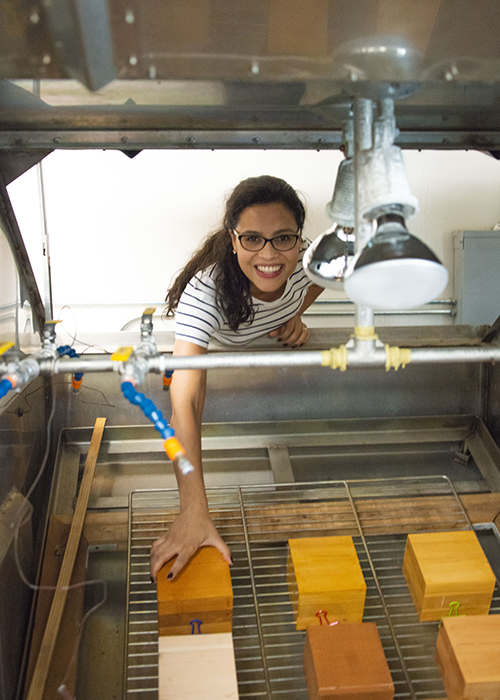MSU research aiding essential wood products industry
Contact: Karen Brasher

STARKVILLE, Miss.—Amid the COVID-19 outbreak, the U.S. Department of Homeland Security has identified the wood products industry as an essential critical infrastructure workforce.
Mississippi State has the only research program in the state dedicated to expanding the service and use of wood products, delivering research to the state’s forest industry. While the way the research is being conducted may have shifted temporarily, researchers are leaning into the situation to ensure the important work marches on and the university continues supporting vital industries.
Forestry is the state’s second largest commodity, behind poultry and eggs. Forestry in combination with forest products is even larger and employs a workforce of 69,000 individuals in Mississippi across four sectors—logging, solid wood products, pulp and paper, and wood furniture.
University faculty and staff, under the guidance of the Mississippi Institutions of Higher Learning and the Center for Disease Control and Prevention (CDC), have been conducting research by alternating personnel schedules to maximize productivity while following safety protocols set by the university to protect students, researchers, faculty and staff. In light of Gov. Tate Reeves’ shelter in place order beginning April 3, researchers will be continuing relevant telework research activities, including data analysis, data preparation and resource development.
“We are conducting business, differently than we have done before, but research must continue,” said George Hopper, dean of MSU’s College of Forest Resources and director of the university’s Forest and Wildlife Research Center. “The need for forest products research is vital in a state where over 19.7 million acres or 60 percent of our landmass is forested and predominately owned by private landowners.”
Rubin Shmulsky, head of the Department of Sustainable Bioproducts, explained that research expands opportunities for forest landowners and keeps a crucial industry moving forward.
“We are committed to our mission, even as we respond to a critical, yet fluid public health crisis,” Shmulsky said. “One area of emerging research that will assist landowners, manufacturers and the construction industry alike is the improvement of cross-laminated timber panels.”
Cross-laminated timber (CLT) is a large-scale, prefabricated, solid engineered wood panel, as defined by APA-The Engineered Wood Association. These panels have superior qualities as a building material for long spans in walls, floors and roofs. CLT, which has been used to construct large buildings in Europe for the last two decades, is experiencing rapid growth as a building material in the U.S. and Canada.
The product is made by gluing 2x4, 2x6 and 2x8 pine lumber in a perpendicular pattern. Mississippi State scientists are looking at how notching affects the product strength and trying to find ways to make the panels stronger. Notching of panels helps improve architectural freedom and can reduce construction time. Scientists are experimenting with different notch depths and comparing notched panels to those without notches.
“Findings from this research will improve the market acceptance of this emerging product by providing architects the assurance that southern pine based-CLT panels will provide the strength and stability required in new construction,” Shmulsky said. “We are also working to improve durability by protecting against insects and fungi so that CLT will have a long service life.”
Testing strength and stability in lumber and engineered wood products and then finding ways to improve those variables contributes to the economic value of forest products. Scientists work with numerous types of wood, including engineered wood, to ensure the products have the quality and long service life consumers and industries need.
An example of this work is found in wood utility poles. There are approximately 130 million wood utility poles in service throughout the U.S., according to the North American Wood Pole Council. Southern pine, along with other species, are commonly used as distribution and transmission utility poles.
MSU scientists and the council have a long history of working together to test wood utility poles for durability and strength with the focus on giving manufacturers the tools they need to operate.
“We can all appreciate the value of wood utility poles to deliver our electricity, internet, and telephone services, especially now when most Americans are sheltered at home,” Shmulsky said. “This work is important to continue the service life of wooden utility poles, and their function is an essential part of society.”
Other ongoing work includes developing bio-based plastics, graphene and nanotechnology. Development of an app to identify wood is in the early stages of development.
“We are here to ensure that our wood products industries continue to thrive now and into the future,” Shmulsky added.
For more information about the university’s Forest and Wildlife Research Center, visit FWRC.msstate.edu.
MSU is Mississippi’s leading university, available online at msstate.edu.